Charles E W Bean, Diaries, AWM38 3DRL 606/244/1 - 1916 - 1933 - Part 18
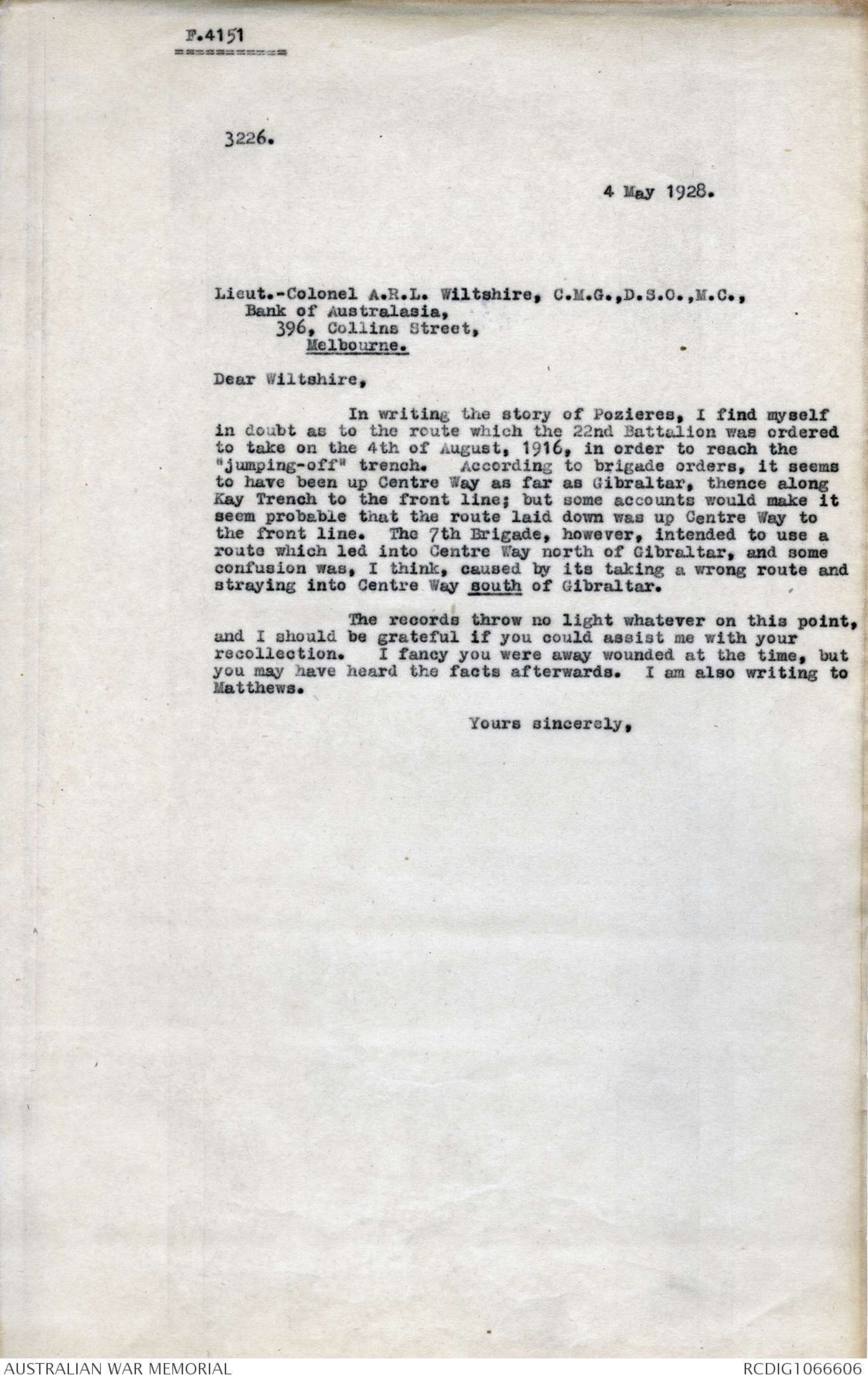
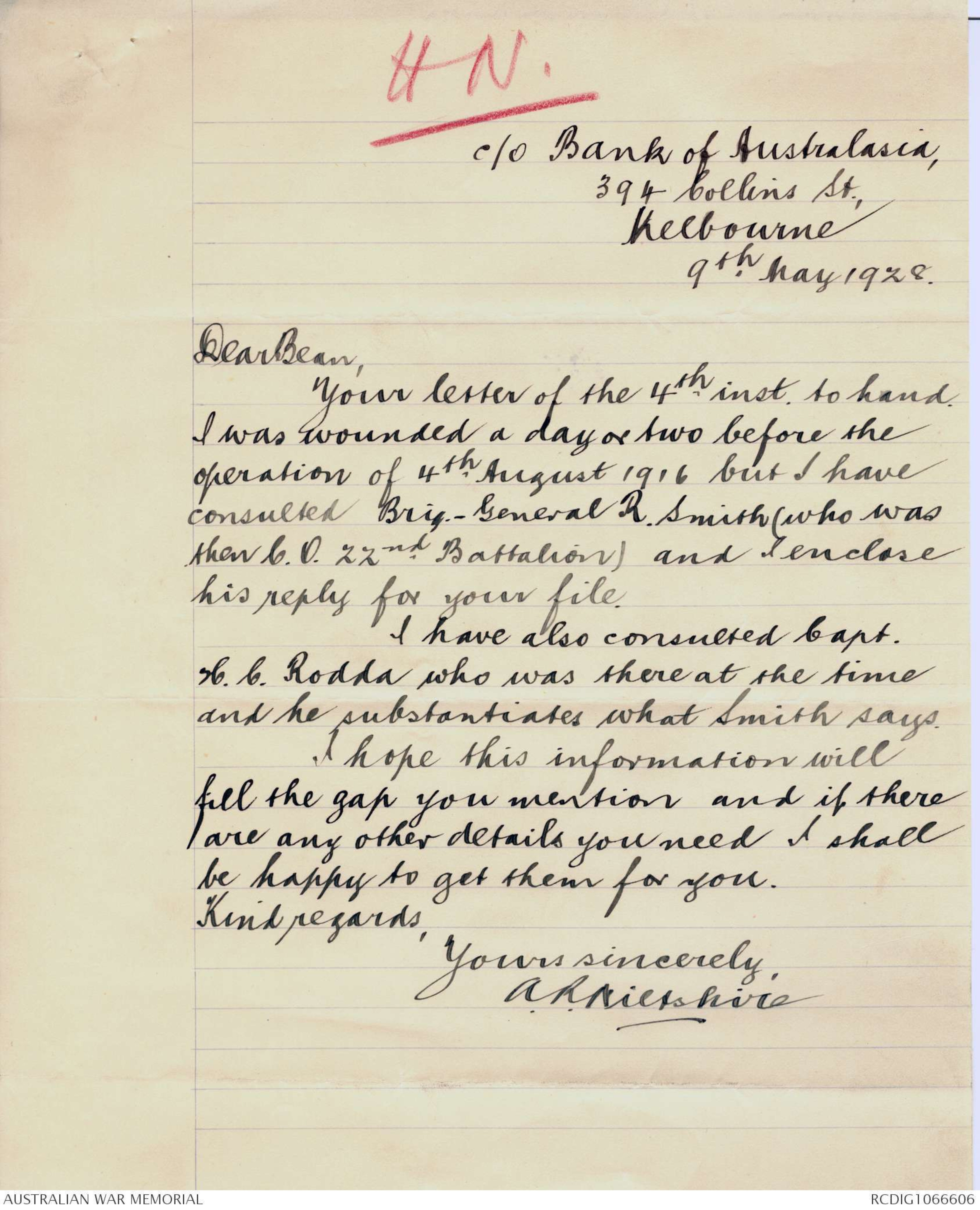
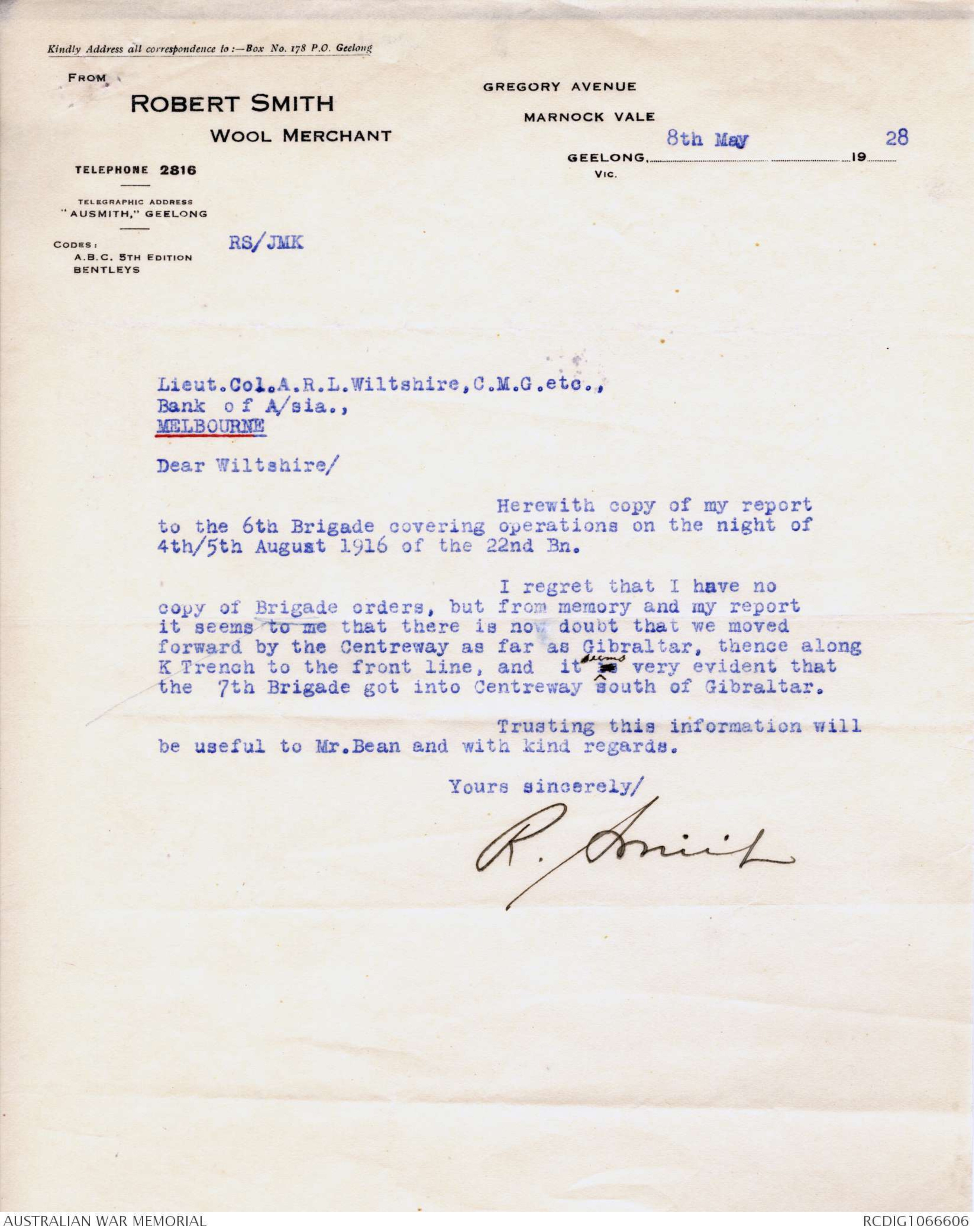

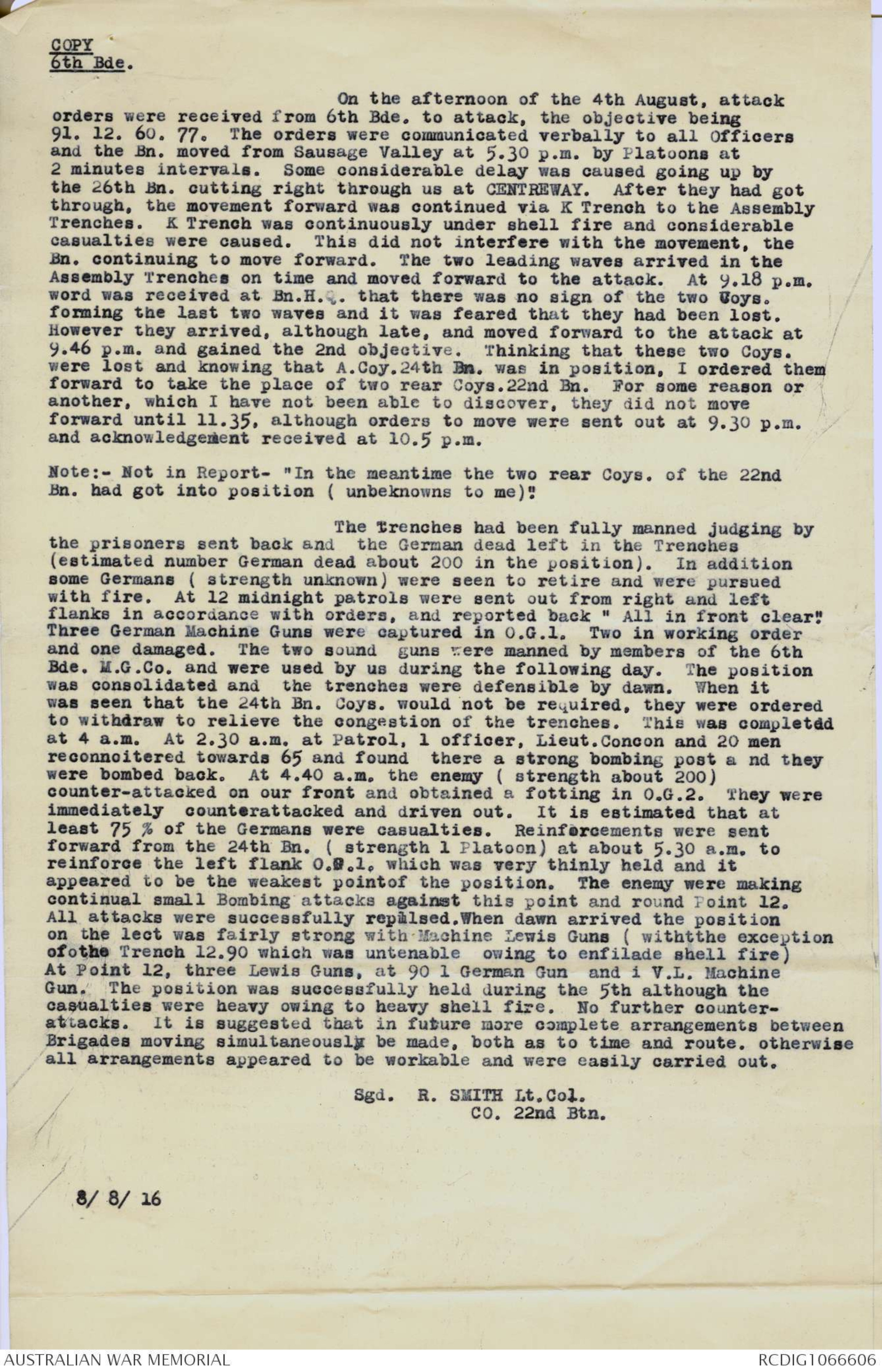
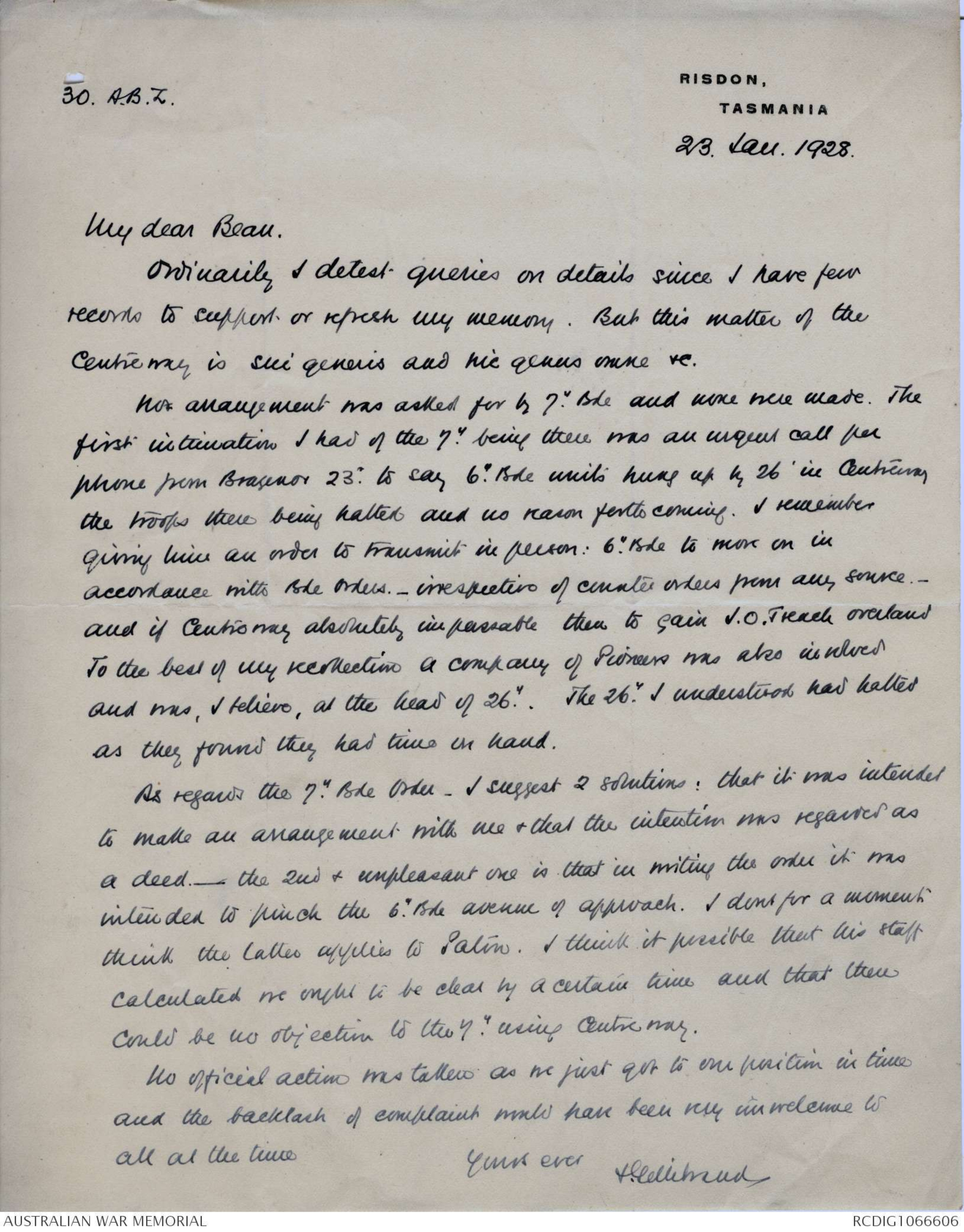

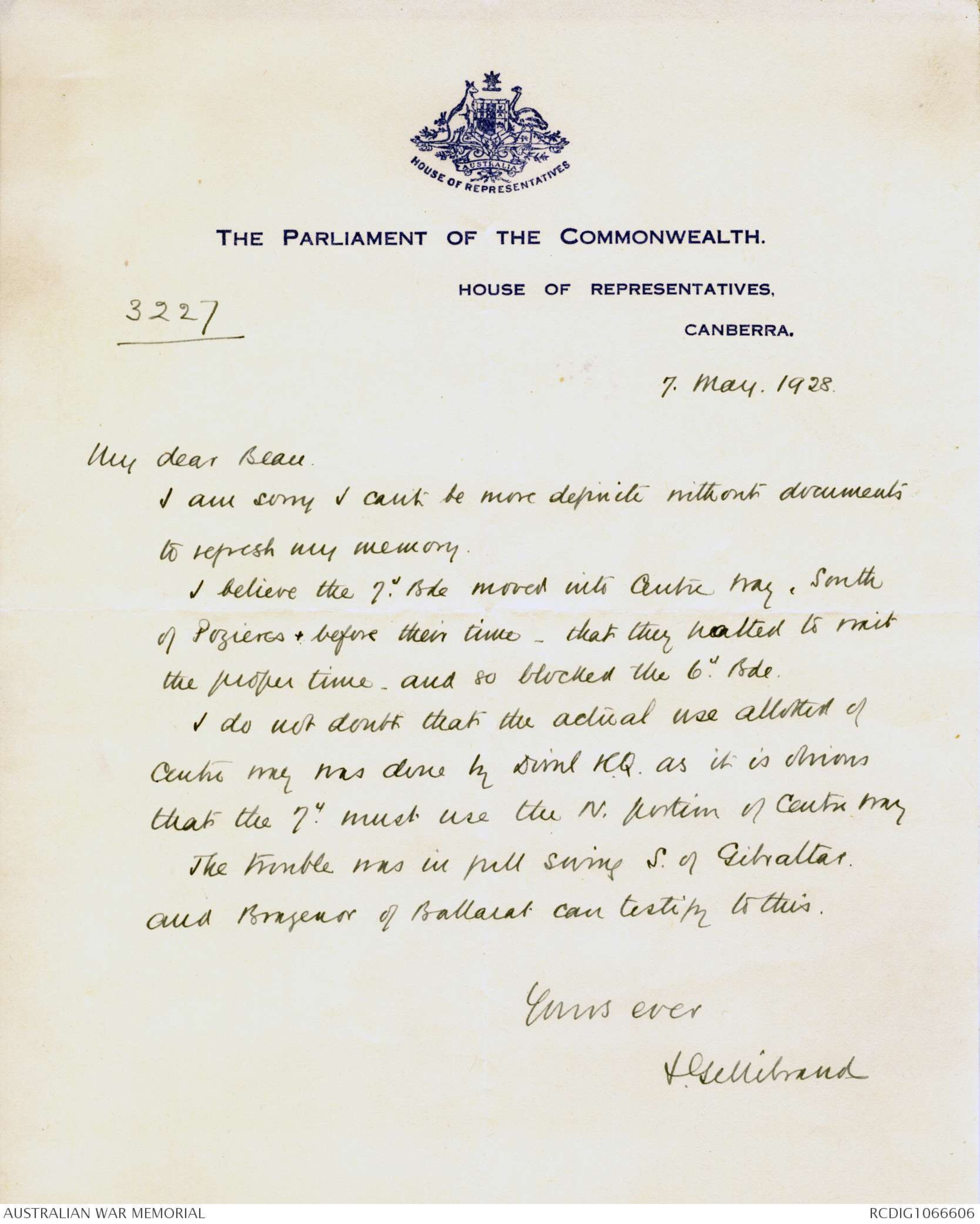
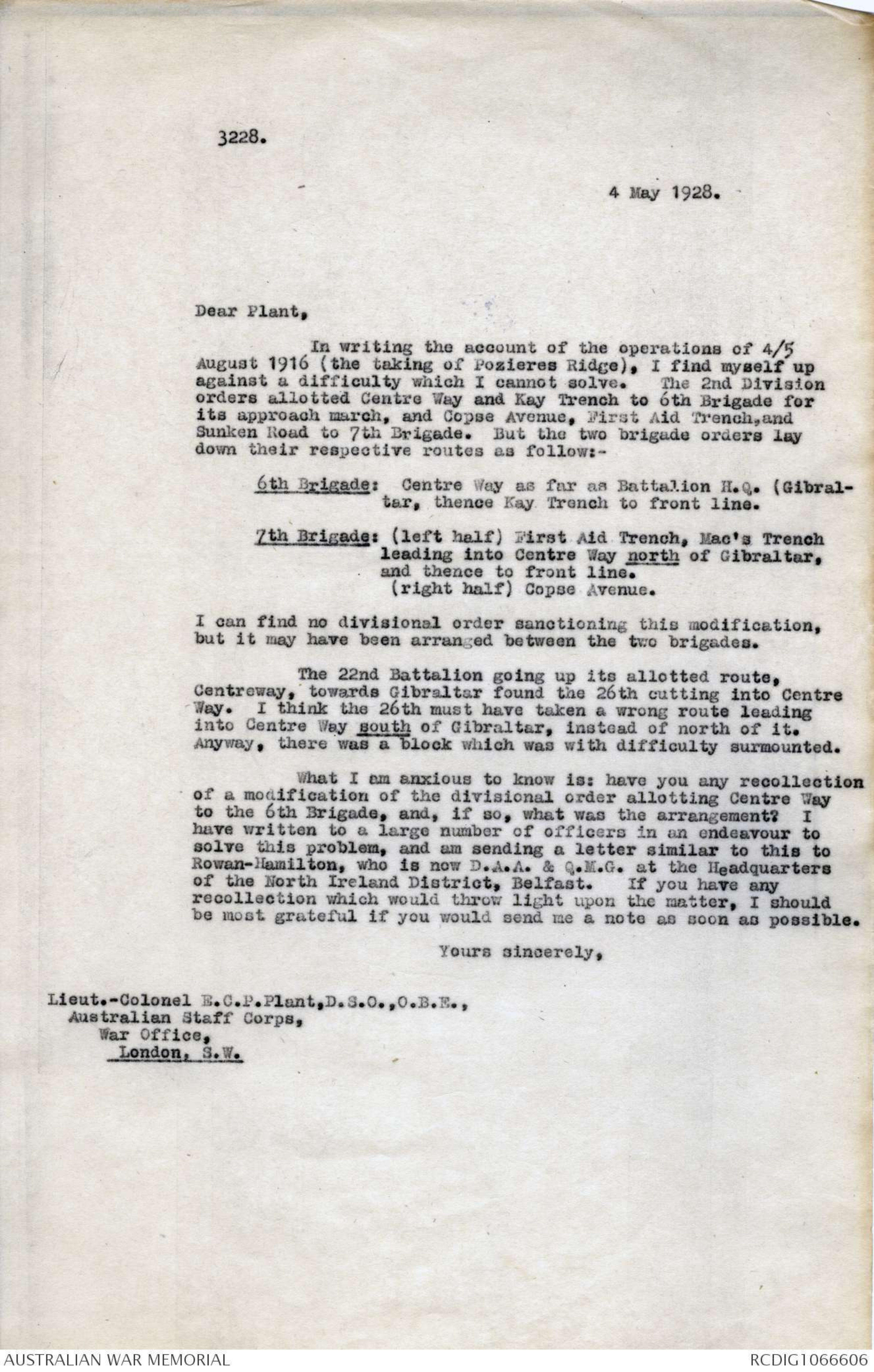
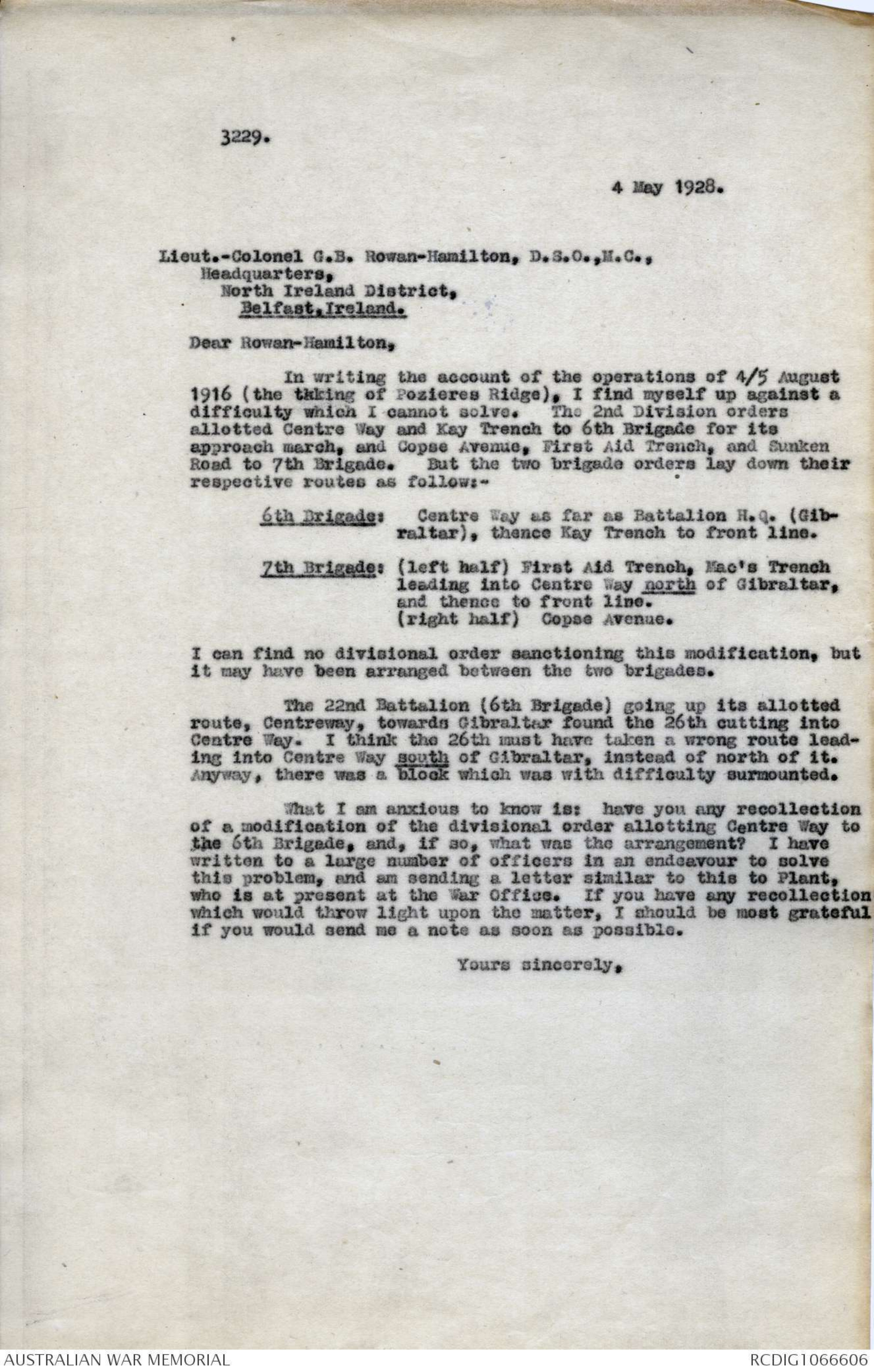
F.4157
3226.
4 May 1928.
Lieut.-Colonel A.R.L. Wiltshire, C.M.G.,D.S.O., M.Co.,
Bank of Australasia,
396, Collins Street,
Melbourne.
Dear Wiltshire,
In writing the story of Pozieres, I find myself
in doubt as to the route which the 22nd Battalion was ordered
to take on the 4th of August, 1916, in order to reach the
jumping-off trench. According to brigade orders, it seems
to have been up Centre Way as far as Gibraltar, thence along
Kay Trench to the front line; but some accounts would make it
seem probable that the route laid down was up Centre Way to
the front line. The 7th Brigade, however, intended to use a
route which led into Centre Way north of Cibraltar, and some
confusion was, I think, caused by its taking a wrong route and
straying into Centre Way south of Gibraltar.
The records throw no light whatever on this point,
and I should be grateful if you could assist me with your
recollection. I fancy you were away wounded at the time, but
you may have heard the facts afterwards. I am also writing to
Matthews.
Yours sincerely,
H.N.
c/o Bank of Australasia,
394 Collins St.
Melbourne
9th May 1928
Dear Bean,
Your letter of the 4th inst. to hand.
I was wounded a day or two before the
operation of 4th August 1916 but I have
consulted Brig-General R. Smith (who was
then C.O. 22nd Battalion) and I enclose
his reply for your file.
I have also consulted Capt.
H. C. Rodda who was there at the time
and he substantiates what Smith says.
I hope this information will
fill the gap you mention and if there
are any other details you need I shall
be happy to get them for you.
Kind regards
Yours sincerely
A.R. Wiltshire
Kindly Address all correspondence to:-Box No. 178 P.O. Geelong
FROM
ROBERT SMITH
WOOL MERCHANT
GREGORY AVENUE
MARNOCK VALE
GEELONG. 8th May
Vic
TELEPHONE 2816
TELEGRAPHIC ADDRESS
"AUSMITH,"-GEELONG
RS/JMK
Codes:
A.B.C. 5TH EDITION
BENTLEYS
Lieut.Col.A.R.L. Wiltshire, C.M.G.etc.,
Bank 0f A/sia.,
MELBOURNE
Dear Wiltshire/
Herewith copy of my report
to the 6th Brigade covering operations on the night of
4th/5th August 1916 of the 22nd Bn.
I regret that I have no
copy of Brigade orders, but from memory and my report
it seems to me that there is no doubt that we moved
forward by the Centreway as far as Gibraltar, thence along
K Trench to the front line, and it ^seems very evident that
the 7th Brigade got into Centreway south of Gibraltar.
Trusting this information will
be useful to Mr.Bean and with kind regards.
Yours sincerely/
R.Smith
COPY
6th Bde.
On the afternoon of the 4th August, attack
orders were received from 6th Bde, to attack, the objective being
91. 12. 60. 77. The orders were communicated verbally to all Officers
and the Bn. moved from Sausage Valley at 5.30 p.m. by Platoons at
2 minutes intervals. Some considerable delay was caused going up by
the 26th Bn. cutting right through us at CENTREWAY. After they had got
through, the movement forward was continued via K Trench to the Assembly
Trenches. K Trench was continuously under shell fire and considerable
casualties were caused. This did not interfere with the movement, the
Bn. continuing to move forward. The two leading waves arrived in the
Assembly Trenches on time and moved forward to the attack. At 9.18 p.m.
word was received at Bn.H.Q. that there was no sign of the two Coys.
forming the last two waves and it was feared that they had been lost.
However they arrived, although late, and moved forward to the attack at
9.46 p.m. and gained the 2nd objective. Thinking that these two Coys.
were lost and knowing that A.Coy. 24th Bn. was in position, I ordered them
forward to take the place of two rear Coys. 22nd Bn. For some reason or
another, which I have not been able to discover, they did not move
forward until 11.35, although orders to move were sent out at 9.30 p.m.
and acknowledgement received at 10.5 p.m.
Note: - Not in Report-" In the meantime the two rear Coys. of the 22nd
Bn. had got into position (unbeknowns to me)".
The Trenches had been fully manned judging by
the prisoners sent back and the German dead left in the Trenches
(estimated number German dead about 200 in the position). In addition
some Germans (strength unknown) were seen to retire and were pursued
with fire. At 12 midnight patrols were sent out from right and left
flanks in accordance with orders, and reported back : All in front clear!
Three German Machine Guns were captured in O.G.1. Two in working order
and one damaged. The two sound guns were manned by members of the 6th
Bde. M.G.Co. and were used by us during the following day. The position
was consolidated and the trenches were defensible by dawn. When it
was seen that the 24th Bn. Coys. would not be required, they were ordered
to withdraw to relieve the congestion of the trenches. This was completed
at 4 a.m. At 2.30 a.m. at Patrol, 1 officer, Lieut, Condon and 20 men
reconnoitered towards 65 and found there a strong bombing post and they
were bombed back. At 4.40 a.m. the enemy (strength about 200
counter-attacked on our front and obtained a footing in 0.G.2. They were
immediately counterattacked and driven out. It is estimated that at
least 75 % of the Germans were casualties. Reinforcements were sent
forward from the 24th Bn. (strength 1 Platoon) at about 5.30 a.m. to
reinforce the left flank O.G.1. which was very thinly held and it
appeared to be the weakest pointof the position. The enemy were making
continual small Bombing attacks against this point and round Point 12.
All attacks were successfully repulsed. When dawn arrived the position
on the left was fairly strong with Machine Lewis Guns (with the exception
of the Trench 12.90 which was untenable owing to enfilade shell fire
At Point 12, three Lewis Guns, at 90 1 German Gun and i V.L. Machine
Gun. The position was successfully held during the 5th although the
casualties were heavy owing to heavy shell fire. No further counter-attacks.
It is suggested that in future more complete arrangements between
Brigades moving simultaneously be made, both as to time and route, otherwise
all arrangements appeared to be workable and were easily carried out.
Sgd. R. SMITH Lt.Col.
Co. 22nd Btn.
8/8/16
COPY
6th Bde.
On the afternoon of the 4th August, attack
orders were received from 6th Bde. to attack, the objective being
91. 12. 60. The orders were communicated verbally to all Officers
and the Bn. moved from Sausage Valley at 5.30 p.m. by Platoons at
2 minutes intervals. Some considerable delay was caused going up by
the 26th Bn. cutting right through us at CENTREWAY. After they had got
through, the movement forward was continued via K Trench to the Assembly
Trenches. K Trench was continuously under shell fire and considerable
casualties were caused. This did not interfere with the movement, the
Bn. continuing to move forward. The two leading waves arrived in the
Assembly Trenches on time and moved forward to the attack. At 9.8 p.m.
word was received at Bn.H.Q. that there was no sign of the two Coys.
forming the last two waves and it was feared that they had been lost.
However they arrived, although late, and moved forward to the attack at
9.46 p.m. and gained the 2nd objective. Thinking that these two Coys.
were lost and knowing that A.Coy, 24th Bn. was in position, I ordered them
forward to take the place of two rear Coys.22nd Bn. For some reason or
another, which I have not been able to discover, they did not move
forward until 11.35, although orders to move were sent out at 9.30 p.m.
and acknowledgement received at 10.5 p.m.
Note: - Not in Report- In the meantime the two rear Coys. of the 22nd
Bn. had got into position (unbeknowns to me):
The Trenches had been fully manned judging by
the prisoners sent back and the German dead left in the Trenches
(estimated number German dead about 200 in the position). In addition
some Germans (strength unknown) were seen to retire and were pursued
with fire. At 12 midnight patrols were sent out from right and left
flanks in accordance with orders, and reported back : All in front clear
Three German Machine Guns were captured in O.G.1 Two in working order
and one damaged. The two sound guns were manned by members of the 6th
Bde. M.G.Co. and were used by us during the following day. The position
was consolidated and the trenches were defensible by dawn. When it
was seen that the 24th Bn. Coys. would not be required, they were ordered
to withdraw to relieve the congestion of the trenches. This was completed
at 4 a.m. At 2.30 a.m. at Patrol, 1 officer, Lieut.Concon and 20 men
reconnoitered towards 65 and found there a strong bombing post and they
were bombed back. At 4.40 a.m. the enemy (strength about 200
counter-attacked on our front and obtained a footing in O.G.2. They were
immediately counterattacked and driven out. It is estimated that at
least 75 9 of the Germans were casualties. Reinforcements were sent
forward from the 24th Bn. (strength 1 Platoon) at about 5.30 a.m. to
reinforce the left flank O.G.1. which was very thinly held and it
appeared to be the weakest pointof the position. The enemy were making
continual small Bombing attacks against this point and round Point 12.
All attacks were successfully repulsed. When dawn arrived the position
on the left was fairly strong with Machine Lewis Guns (with the exception
of the Trench 12,90 which was untenable owing to enfilade shell fire
At Point 12, three Lewis Guns, at 90 1 German Gun and i V.L. Machine
Gun. The position was successfully held during the 5th although the
casualties were heavy owing to heavy shell fire. No further counter-
attacks. It is suggested that in future more complete arrangements between
Brigades moving simultaneously be made, both as to time and route, otherwise
all arrangements appeared to be workable and were easily carried out.
Sgd. R. SMITH Lt.Col.
CO. 22nd Btn.
8/8/16
30. A.B.L.
RISDON.
TASMANIA
23. Jan. 1928.
My dear Bean.
Ordinarily I detest queries on details since I have few
records to support or refresh my memory. But this matter of the
centreway is sui generis and nic genus omne &c.
No arrangement was asked for by 7th and none were made. The
first inclination I had of the 7th being there was an urgent call per
phone from Brazenor 23rd to say 6th Bde units hung up by 26th in Centreway
the troops there being halted and no reason forth coming. I remember
giving twice an order to transmit in person. 6th Bde to move on in
accordance with Bde orders - irrespective of counter orders from any source.-
and if Centro may absolutely impassable then to gain J.O. Trench overland
To the best of my recollection a company of Pioneers was also involved
and was, I believe, at the head of 26th. The 26th I understood had halted
as they found they had time in hand
As regards the 7th Bde order - I suggest 2 solutions: that it was intended
to make an arrangement with me & that the intention was regarded as
a deed. - the 2nd & unpleasant one is that in writing the order it was
intended to pinch the 6th Bde avenue of approach. I dont for a moment
think the latter applies to Paton. I think it possible that his staff
calculated we ought to be clear by a certain time and that there
could be no objection to the 7th using Centreway.
No official action was taken as we just got to one position in time
and the backlash of complaint would have been very unwelcome to
all at the time
Yours ever
J.Gellibrand
3227.
4 May 1928.
Dear Gelly,
Re night of 4 August 1916 at Pozieres, I find that,
although Centre Way had been allotted to your brigade, the 6th
Brigade orders lay down that it was to be used as far as
Gibraltar, the troops then branching off and taking May Trench
to the front line. The 7th Brigade order lays down that the
left portion of the brigade was to use Centre Way north of
Gibraltar, passing into it through Mac's Trench. Although no
other evidence exists, it looks to me as though there may have
been, between the brigades, some arrangement which has faded
from memory, and that the trouble arose through the 7th Brigade
passing by mistake into Centre Way through Pozieres Trench or
some overland route south of Gibraltar. I am writing to
Wiltshire, Matthews, Plant and Rowan-Hamilton, but would be
grateful if you could tell me whether this new suggestion calls
anything to your memory.
Yours ever,
Major-General John Gellibrand, K.C.B.,
House of Representatives,
Canberra
AUSTRALIA
HOUSE OF REPRESENTATIVES
THE PARLIAMENT OF THE COMMONWEALTH.
HOUSE OF REPRESENTATIVES,
CANBERRA.
3227
7. May. 1928.
My dear Bean.
I am sorry I can't be more definite without documents
to refresh my memory.
I believe the 7th Bde moved into Centre Way, South
of Pozieres & before their time - that they halted to wait
the proper time and so blocked the 6th Bde.
I do not doubt that the actual use allotted of
Centre Way was done by Divnl HQ. as it is obvious
that the 7th must use the N. portion of Centre Way
The trouble was in full swing S. of Gibraltar.
and Brazenor of Ballarat can testify to this.
Yous ever
J. Gellibrand
3228.
4 May 1928.
Dear Plant,
In writing the account of the operations of 4/5
August 1916 (the taking of Pozieres Ridge), I find myself up
against a difficulty which I cannot solve. The 2nd Division
orders allotted Centre Way and Kay Trench to 6th Brigade for
its approach march, and Copse Avenue, First Aid Trench, and
Sunken Road to 7th Brigade. But the two brigade orders lay
down their respective routes as follows-
6th Brigade: Centre Way as far as Battalion H.Q. (Gibraltar,
thence Kay Trench to front line.
7th Brigade: (left half) First Aid French, Mac's Trench
leading into Centre Way north of Gibraltar,
and thence to front Line.
(right half) Copse Avenue.
I can find no divisional order sanctioning this modification,
but it may have been arranged between the two brigades.
The 22nd Battalion going up its allotted route
Centreway, towards Gibraltar found the 26th cutting into Centre
Way. I think the 26th must have taken a wrong route leading
into Centre Way south of Gibraltar, instead of north of it.
Anyway, there was a block which was with difficulty surmounted.
What I am anxious to know is: have you any recollection
of a modification of the divisional order allotting Centre Way
to the 6th Brigade, and, if so, what was the arrangement? I
have written to a large number of officers in an endeavour to
solve this problem, and am sending a letter similar to this to
Rowan-Hamilton, who is now D.A.A. & Q.M.G. at the Headquarters
of the North Ireland District, Belfast. If you have any
recollection which would throw light upon the matter, I should
be most grateful if you would send me a note as soon as possible.
Yours sincerely,
Lieut.-Colonel E.C.P.Plant, D.S.O.,O.B.E.,
Australian Staff Corps,
War Office
London, S.W.
3229.
4 May 1928.
Lieut.- Colonel G.B. Rowan-Hamilton, D.S.O.,M.C.,
Headquarters,
North Ireland District,
Belfast Ireland.
Dear Rowan-Hamilton,
In writing the account of the operations of 4/5 August
1916 (the taking of Pozieres Ridge), I find myself up against a
difficulty which I cannot solve. The 2nd Division orders
allotted Centre Way and Kay Trench to 6th Brigade for its
approach march, and Copse Avenue, First Aid Trench, and Sunken
Road to 7th Brigade. But the two brigade orders lay down their
respective routes as follows-
6th Brigade: Centre Way as far as Battalion H.Q. (Gibraltar,
thence Kay Trench to front line.
7th Brigade: (left half) First Aid French, Mac's Trench
leading into Centre Way north of Gibraltar,
and thence to front Line.
(right half) Copse Avenue.
I can find no divisional order sanctioning this modification, but
1t may have been arranged between the two brigades.
The 22nd Battalion (6th Brigade) going up its allotted
route, Centreway, towards Gibraltar found the 26th cutting into
Centre Way. I think the 26th must have taken a wrong route leading
into Centre Way South of Gibraltar, instead of north of it.
Anyway, there was a block which was with difficulty surmounted.
That I am anxious to know is: have you any recollection
of a modification of the divisional order allotting Centre Way to
the 6th Brigade, and, if so, what was the arrangement? I have
written to a large number of officers in an endeavour to solve
this problem, and am sending a letter similar to this to Plant,
who is at present at the War Office. If you have any recollection
which would throw light upon the matter, I should be most grateful
if you would send me a note as soon as possible.
Yours sincerely,
 Sam scott
Sam scottThis transcription item is now locked to you for editing. To release the lock either Save your changes or Cancel.
This lock will be automatically released after 60 minutes of inactivity.